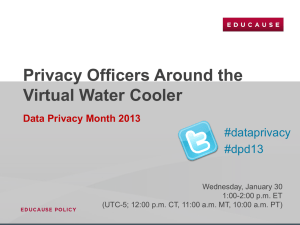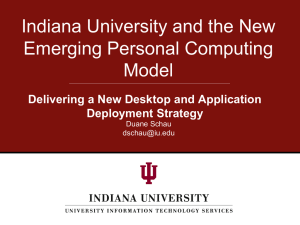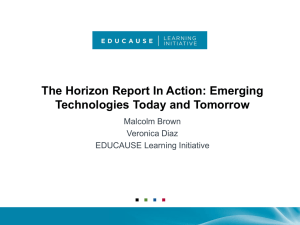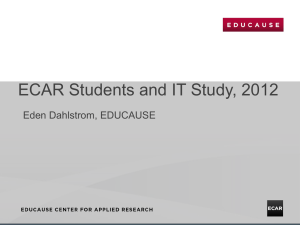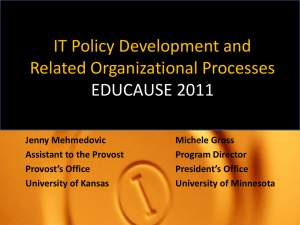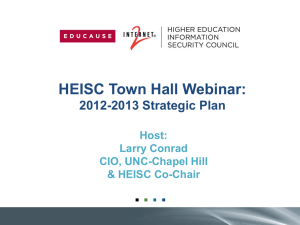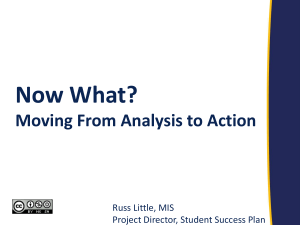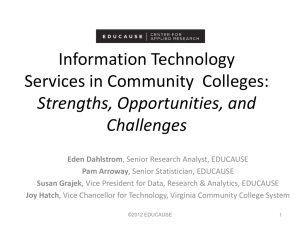Workforce Slides
advertisement
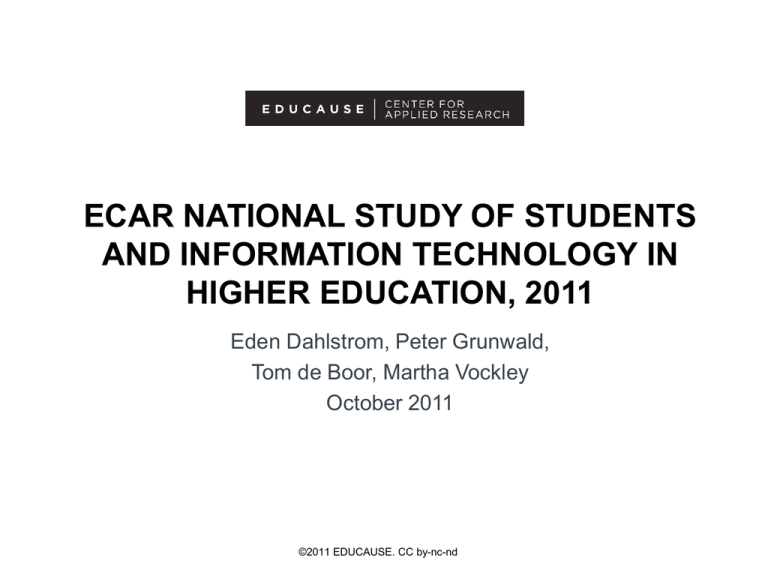
ECAR NATIONAL STUDY OF STUDENTS AND INFORMATION TECHNOLOGY IN HIGHER EDUCATION, 2011 Eden Dahlstrom, Peter Grunwald, Tom de Boor, Martha Vockley October 2011 ©2011 EDUCAUSE. CC by-nc-nd CONTENTS Study Overview Key Findings Technology Ownership (slides 9–13) Technology Use and Value (slides 14–31) Institutional and Instructional Technology Competencies (slides 32–40) Technology for Connecting and Relationships (slides 41–44) Online Learning (slides 45–47) ECAR Recommendations Source: Dahlstrom, Eden, Tom de Boor, Peter Grunwald, and Martha Vockley, with a Foreword by Diana Oblinger. The ECAR National Study of Undergraduate Students and Information Technology, 2011 (Research Report). Boulder, CO: EDUCAUSE Center for Applied Research, October 2011, available from http://www.educause.edu/ecar 2 ©2011 EDUCAUSE. CC by-nc-nd STUDY OVERVIEW ©2011 EDUCAUSE. CC by-nc-nd 3 ECAR STUDENT STUDY, 2011 RESEARCH OBJECTIVES Assess students’ technology ownership and use Explore how effectively instructors and institutions are using technology Understand students’ technology skill level Gauge students’ technology perceptions, attitudes, and preferences ©2011 EDUCAUSE. CC by-nc-nd 4 ECAR STUDENT STUDY, 2011 SAMPLE Responses from 3,000 students at 1,179 colleges and universities provided a nationally representative sample of students Data are weighted to match statistics from the National Center of Education Statistics for the composition of college students in the United States on the following variables: Year (freshman, sophomore, junior, senior) Gender Age Region Major of study Institution type (public, private, for-profit) Institution size Institution type (4-year vs. 2-year) Ethnicity ©2011 EDUCAUSE. CC by-nc-nd 5 ECAR STUDENT STUDY, 2011 SAMPLE COMPOSITION Year Freshman Sophomore Junior Senior Gender Male Female Age 18–24 25–34 35–44 45+ Region Northeast South Midwest West Ethnicity White Black/African American Hispanic American Indian or Alaskan native Asian/Pacific Islander Other Prefer not to answer Percentage 21% 31% 25% 23% N 640 918 760 682 43% 57% 1,283 1,717 60% 23% 9% 8% 1,802 709 259 230 21% 25% 33% 21% 630 750 990 630 66% 13% 11% 1% 7% 1% 2% 1,975 398 344 30 201 37 65 Major Biological/life sciences Business, management, marketing Education, including physical education Engineering, including computer science Liberal arts and sciences/general studies Physical sciences, including math Social sciences Fine arts Other Undecided Institution Type Public Private For-profit Enrollment Less than 500 500 to 999 1,000–4,999 5,000–9,999 10,000–19,999 20,000 or more Type A two-year or community college A four-year college or university Student Enrollment Status Full-time Part-time ©2011 EDUCAUSE. CC by-nc-nd Percentage 14% 21% 7% 7% 11% 2% 17% 6% 13% 2% N 408 642 198 213 342 72 498 168 402 57 73% 23% 4% 2,190 691 118 1% 3% 19% 18% 24% 35% 30 90 570 540 720 1,049 37% 63% 1,110 1,890 82% 18% 2,459 541 6 KEY FINDINGS ©2011 EDUCAUSE. CC by-nc-nd 7 ECAR STUDENT STUDY, 2011 KEY FINDINGS Students are drawn to hot technologies but rely on more traditional devices. Students recognize major academic benefits of technology. Students report uneven perceptions of institutions and instructors on technology. Facebook-generation students juggle personal and academic interactions. Students prefer, and say they learn more in, classes with online components. ©2011 EDUCAUSE. CC by-nc-nd 8 KEY FINDING 1 – STUDENTS ARE DRAWN TO HOT TECHNOLOGIES BUT RELY ON TRADITIONAL DEVICES ©2011 EDUCAUSE. CC by-nc-nd 9 DRAWN TO HOT TECHNOLOGIES… PREFER SMALL, MOBILE DEVICES Technology Ownership Technology 6 5 7 12 11 14 3 10 1 4 2 8 Q1. Which of the following items do you own? 1 Laptop 87% 2 Printer 81% 3 DVD Player 75% 4 USB Thumbdrive 70% 5 Wi-Fi* 67% 6 Stationary gaming device 66% 7 Ipod 62% 8 HDTV 56% 9 Smartphone 55% 10 Digital Camera 55% 11 Webcam 55% 12 Desktop Computer 53% 13 Handheld Gaming Device 38% 14 Netbook 11% 15 iPad 8% *Likely interpreted by the respondent as having access to Wi-Fi 9 13 ©2011 EDUCAUSE. CC by-nc-nd Students Own 15 Traditional age college students (18-24) and those from households of $100K+ own more technology than their counterparts. 10 10 DRAWN TO HOT TECHNOLOGIES… RELIANT ON TRADITIONAL DEVICES Students Own Q1. Which of the following items do you own? ©2011 EDUCAUSE. CC by-nc-nd 11 DRAWN TO HOT TECHNOLOGIES… OPINIONS ON PLATFORM PREFERENCE Institution Preference Student Preference Q4b. Does your college or university officially prefer you use one computing platform over another? Q4c. And, what is your preference? Do you prefer to use one platform over another? ©2011 EDUCAUSE. CC by-nc-nd 12 DRAWN TO HOT TECHNOLOGIES… CARNEGIE CLASS DIFFERENCES Students at community colleges are more likely to own stationary technologies (e.g., desktop computers and stationary gaming and video devices), particularly in comparison to students at research institutions Students at institutions that award master’s and doctorate degrees are more likely to own portable technologies (e.g., laptops, iPods, webcams, thumb drives, and Wi-Fi devices) Still, there are both mobile devices (e.g., iPads) and stationary technologies (e.g., HDTVs) for which no significant differences exist among students at institutions of different Carnegie Classifications. ©2011 EDUCAUSE. CC by-nc-nd 13 KEY FINDING 2 – STUDENTS RECOGNIZE MAJOR ACADEMIC BENEFITS OF TECHNOLOGY ©2011 EDUCAUSE. CC by-nc-nd 14 ACADEMIC BENEFITS… DEVICES USED FOR ACADEMICS Technology use for academics Technology Total 12 4 8 3 11 14 7 Students Use For Academics 9 1 5 2 10 Q1. Which of the following items do you own? Q2a. Regardless of whether you own it, which of the following have you used for at least one course or academic activity in the past year? (Owners) 1 Laptop 85% (92%) 2 Printer 79% (84%) 3 Desktop Computer 63% (78%) 4 Wi-Fi 60% (75%) 5 USB Thumbdrive 59% (74%) 6 Smartphone 37% (60%) 7 DVD Player 30% (33%) 8 iPod 23% (22%) 9 Digital Camera 21% (32%) 10 HDTV 18% (26%) 11 Webcam 17% (24%) 12 Stationary gaming device 12% (15%) 13 iPad 12% (67%) 14 Netbook 11% (70%) 15 Handheld Gaming Device 7% (13%) ( ) = use among owners 6 15 ©2011 EDUCAUSE. CC by-nc-nd ©2011 EDUCAUSE. CC by-nc-nd 13 Traditional age college students (18-24) and those from households of $100K+ use more technology 15 than their counterparts 15 ACADEMIC BENEFITS… CORE SOFTWARE IS CENTRAL TO SUCCESS Frequency of Use for School or Personal Purposes Q5b. Thinking about the most recent school year, how often did you do the following, whether it was for school or personal purposes? ©2011 EDUCAUSE. CC by-nc-nd 16 ACADEMIC BENEFITS… STUDENTS VALUE SOFTWARE BASICS Value of Technology to Academic Success Percent Responding “Extremely Valuable” Q7. How valuable are each of the following when it comes to your academic success? Please consider only your academic success when rating these technologies, not the other aspects of your life. ©2011 EDUCAUSE. CC by-nc-nd 17 ACADEMIC BENEFITS… ACCESSING RESOURCES AND EFFICIENCY Agreement with Statements about Academic Success Percent Responding “Agreeing or Strongly Agreeing” Gives me access to a wide range of resources Makes it easy to track my academic progress Simplifies administrative-related activities such as registering for classes, paying tuition, etc. Helps me know how I am doing in a course Extends learning beyond the classroom Helps me do my work faster Is an efficient way to store examples of my work Allows me to produce higher quality work Makes it easier to get help when I need it Allows me to take control of my own learning Makes college easier Makes learning more creative Better prepares me for entering the workforce Makes learning more fun Makes me feel more connected to what’s going on at the college/university Makes coursework/lectures more engaging Enables me to reach my true academic potential Elevates the level of teaching Gives me access to experts in my field Makes me feel connected to professors and other college/university staff Makes me feel connected to other students Makes my academic experience more individualized/personalizes curriculum Makes classes more relevant to real life Q12. To what extent do you agree with each of the following statements regarding technology when it Better prepares me for getting into graduate school comes to your academic experience? Helps me think out of the box ©2011 EDUCAUSE. CC by-nc-nd 18 ACADEMIC BENEFITS… FOUR FACTORS FOR ACADEMIC SUCCESS Avg. Agreement with Statements Gives Students Access to Resources and Progress Reports Easy to track my academic progress Helps me know how I am doing Simplifies administrative-related activities Gives me access to resources Easier to get help when I need it Makes Students More Efficient Helps me do my work faster Allows me to produce higher-quality work Efficient way to store examples of work Makes college easier Facilitates Connecting with Others Feel connected to what's going on Gives me access to experts in my field Feel connected to other students Feel connected to professors/staff Makes Learning More Engaging and Relevant Learning more creative Learning more fun Think out of the box Individualized/personalized More relevant to real life More engaging Elevates teaching Reach academic potential ©2011 EDUCAUSE. CC by-nc-nd Take control of own learning Extends learning beyond classroom Prepares me for the workforce Prepares me for graduate school 19 ACADEMIC BENEFITS…RELATIONSHIPS BETWEEN TECHNOLOGIES AND BENEFITS Access to Resources & Progress Reports Laptop computer Document camera Wi-Fi Printer Wi-Fi Printer Internet device that attaches to TV Digital video camera USB drive Projector Efficiency Laptop Connecting With Others Engagement and Relevance Smartphone iPad Digital point and shoot camera Scanner Digital video camera Internet device that attaches to TV Interactive whiteboard Scanner iPhone/ smartphone Student clickers/ student response systems iPad eReader Student clickers/ student response systems Mp3 player ©2011 EDUCAUSE. CC by-nc-nd Digital cameras DVD player Document camera DVR Desktop computer Webcam 20 ACADEMIC BENEFITS… COMMUNICATION TOOLS - MASS ADOPTION Frequency of Use for School or Personal Purposes Q5a. Thinking about the most recent school year, how often did you do the following, whether it was for school or personal purposes? ©2011 EDUCAUSE. CC by-nc-nd 21 ACADEMIC BENEFITS… A BLIZZARD OF MESSAGES Frequent e-mail users (75% of students) send or receive an average of 25 e-mails a day. Frequent texters (74% of students) send or receive an average of 84 text messages a day. Frequent Facebook users (58% of students) log into and/or check Facebook 13 times a day. Frequent Twitter users (11% of students) read or post 112 tweets a day. ©2011 EDUCAUSE. CC by-nc-nd 22 ACADEMIC BENEFITS…SMARTPHONES—NOT JUST FOR COMMUNICATION Ways Smartphones Are Used for Academic Work (Among Users) n= 1,122 Opportunities exist for universities and students to take greater advantage of smartphone technology when it comes to administrative activities, such as ordering transcripts, purchasing textbooks, accessing financial aid information, and registering for courses. Q11. You said you own an iPhone or smartphone. Which of the following are ways you use your iPhone or smartphone for your academic work? ©2011 EDUCAUSE. CC by-nc-nd 23 ACADEMIC BENEFITS… TOP APPS FOR MOBILES Types of Apps Used Most For Coursework and other University-Related Activities (Among smartphone and tablet users) n= 1,230 Q10b. Which of the following types of mobile or tablet apps do you use for coursework or other college/universityrelated activities? Please do not include any apps that you only use for personal, non-academic purposes. ©2011 EDUCAUSE. CC by-nc-nd 24 ACADEMIC BENEFITS…THE ONE WEBSITE STUDENTS CAN’T LIVE WITHOUT 36% 2% 3% 11% 2% 2% 8% An additional 88 websites/online resources were mentioned by less than 2% of the sample. Q15. When it comes to your success as an undergraduate, what is one website or online resource you couldn’t live without? ©2011 EDUCAUSE. CC by-nc-nd 25 ACADEMIC BENEFITS… VALUE ANYTIME, ANYWHERE ACCESS Wi-Fi access is instrumental to student success, and students want access from everywhere on campus. Value of Technology for Academic Success Percent Responding “Extremely Valuable” (Among users and those whose instructors use) N = bases vary Q4a. And, how valuable are each of the following when it comes to your academic success, (whether it’s your own personal device, or something your instructor or university uses as a part of your academic experience)? Please consider only your academic success when rating these technologies, not the other aspects of your life. ©2011 EDUCAUSE. CC by-nc-nd 26 ACADEMIC BENEFITS…TECHNOLOGIES VALUED ALIGN WITH INSTRUCTORS’ USE Instructors’ Use There is a wide range of technologies with potential educational benefits that aren’t being used yet. Q2b. You’ve told us about all the different kinds of technological devices you own and use for academic work. Now tell us, which of the following your instructors used to teach, mentor and communicate with you in the past year? ©2011 EDUCAUSE. CC by-nc-nd 27 ACADEMIC BENEFITS… MANY LACK CONFIDENCE IN THEIR SKILLS Student Technology Skill Level Percentage Responding 4 or 5 “My skill level meets my needs” (out of 5) Q6. How comfortable do you feel with your ability to use each of the following? ©2011 EDUCAUSE. CC by-nc-nd 28 ACADEMIC BENEFITS… E-MAIL HITS THE TOP OF WISH LIST Wish Instructor Used More Often E-mail Course or learning management system E-books or e-textbooks Presentation software Online forums or bulletin boards Online chats, chat events, webinars College/university library website Web-based videos Freely available course content Video-sharing websites Word processors Podcasts and webcasts Text message Spreadsheets Facebook Tagging/bookmarking/liking Simulations or educational games Blogs Wikis Web-based citation/bibliography tools Social studying sites Instant message Telephone-like communication over the Internet Graphics software Video-creation software Online multi-user computer games Programming languages E-portfolios *Only items mentioned by at least 5% of students are shown Web-based music Why Students Say they Want “More” (From open-end responses) "I wish instructors e-mailed more so that students and teachers could communicate easier, faster, and more efficiently." "Blackboard makes viewing things in your class easier and more convenient." "E-books are cheaper than regular hardbound textbooks, easier to carry around, and more accessible all the time." "I find PowerPoint presentations easy to follow & understand." Q8A. Which things do you wish your instructors used more? ©2011 EDUCAUSE. CC by-nc-nd 29 ACADEMIC BENEFITS…CARNEGIE DIFFERENCES IN TECHNOLOGY VALUE Students in community colleges are generally less likely to engage in many technology applications and activities than students at institutions of other Carnegie Classifications. Students in community colleges tend to find non-core technologies more valuable than do students in doctoralgranting institutions. These technologies include multiuser games, educational simulations and games, speech recognition software, and, to a lesser extent, virtual worlds, geotagging, and graphics software. ©2011 EDUCAUSE. CC by-nc-nd 30 ACADEMIC BENEFITS…CARNEGIE DIFFERENCES IN TECHNOLOGY VALUE Across a broad range of technologies, students at institutions that award doctorate degrees are more comfortable with their skills than students at community colleges and, in many cases, students in institutions that award bachelor’s and master’s degrees. Students at institutions that award doctorate degrees tend to find a number of core communication, course, and social networking tools more valuable than their counterparts in community colleges. ©2011 EDUCAUSE. CC by-nc-nd 31 KEY FINDING 3 – STUDENTS REPORT UNEVEN PERCEPTIONS OF INSTITUTIONS AND INSTRUCTORS ON TECHNOLOGY ©2011 EDUCAUSE. CC by-nc-nd 32 UNEVEN PERCEPTIONS OF TECHNOLOGY… EFFECTIVE, FREQUENT, AND SEAMLESS USE The strongest predictors of how students rate their institution in its use of technology their instructors’ effective use of technology their instructors’ use of technology frequently enough the seamless integration of technology into their courses These three predictors alone accounted for approximately 54% of the variance in students’ perceptions of their institution’s effectiveness in using technology. ©2011 EDUCAUSE. CC by-nc-nd 33 UNEVEN PERCEPTIONS OF TECHNOLOGY… NO MAGIC BULLETS Students at institutions rated as highly effective in the use of technology say they engage in about as many software activities as their peers and that their instructors use about the same number of devices in their coursework. There are no significant differences between students’ frequency of use of most software applications at institutions rated effective and less effective in their use of technology. Virtually no high or even moderate correlations exist between individual technologies and any of the major academic benefits of technology described earlier. Differentiating technologies, where they exist, often are mundane (e.g., printers, spreadsheets, even USB thumb drives). ©2011 EDUCAUSE. CC by-nc-nd 34 UNEVEN PERCEPTIONS OF TECHNOLOGY… DELIVERY OF BASIC ONLINE SERVICES Institutional Performance in Online Delivery of Services Percentage rating 4 or 5 (out of 5) Service Not Offered Service Not Used 1% 2% -- 1% 1% 6% 4% 7% 1% 7% 6% 11% Q16. How would you rate your college/university with regards to the following online services? ©2011 EDUCAUSE. CC by-nc-nd 35 UNEVEN PERCEPTIONS OF TECHNOLOGY… VALUE VS. EFFECTIVE USE average Used Most Effectively by Instructors Projector Technology valued most and used most effectively by professors Document camera/ digital overhead projector Wi-Fi Laptop computer Desktop computer Interactive whiteboard Internet-ready TV Valued Most for Academic Success Valued Least for Academic Success Printer USB drive Digital SLR camera Netbook average HDTV Windows phone DVD player Internet device that attaches to TV Other tablet Flip video camera Smartpen Clickers/response systems Scanner Blackberry eReader Webcam Digital video camera Digital Point and Shoot Android iPod Other Smart Phone iPhone mp3 player iPad Other Mobile / Cell Phone Used Least Effectively by Instructors Items with Ns below 45 are not included on this chart. Q3. How effectively did your instructors use these technologies to teach, mentor and communicate with you in the past year? Q4a. And, how valuable are each of the following when it comes to your academic success? 36 ©2011 EDUCAUSE. CC by-nc-nd UNEVEN PERCEPTIONS OF TECHNOLOGY… SOFTWARE VALUE VS. WISHED USED MORE Most Wish Instructor Used More Highly valued technologies students wish instructors used more Web-based videos Video-sharing websites Online chats, events, Online forums or bulletin boards webinars Freely available course content Podcasts and webcasts Facebook Simulations or Tagging/bookmark educational games ing/liking Blogs Graphics Web-based Social studying sites Software citation/bibliography tools Telephone – like communication over Instant Message internet Online multi-user computer Programming languages E-Portfolios Web-based music Twitter Photo-sharing websites Audio-creation software Online virtual worlds Linked In Geo-Tagging Internet content via TV Other social Speech recognition software networking websites VALUE MOST VALUE LEAST average 1ST priority average Note: Students may value creative technologies less in an academic context because their instructors don’t model their use. Least Wish Instructor Used More Items with Ns below 45 are not included on this chart. Q7. How valuable are each of the following when it comes to your academic success? Q8A. Which things do you wish your instructors used more? ©2011 EDUCAUSE. CC by-nc-nd 37 UNEVEN PERCEPTIONS OF TECHNOLOGY… INSTRUCTORS USE “TYPICAL” TECHNOLOGY Instructors’ Effective Use of Technology Percentage responding “extremely effectively” (Among those whose instructors use), n=base sizes vary Q3. How effectively did your instructors use these technologies to teach, mentor and communicate with you in the past year? ©2011 EDUCAUSE. CC by-nc-nd 38 UNEVEN PERCEPTIONS OF TECHNOLOGY… OPPORTUNITIES FOR IMPROVEMENT Agreement with Statements about Technology Strongly Agree Strongly Disagree My institution uses the technology it has effectively I know more about how to use technology than my professors My instructors use technology frequently enough Technology makes professors better at their job My institution needs more technology Technology is integrated seamlessly into my courses My instructors use technology effectively My instructor requires help to get technology up and running Instructors don’t know how to use technology that is available Q13. And how much do you agree with each of the following statements about technology, as it relates to your college experience? ©2011 EDUCAUSE. CC by-nc-nd 39 UNEVEN PERCEPTION OF TECHNOLOGY… TECHNOLOGY ASSISTANCE OPPORTUNITIES Professors should be able to actually use the technology that is available to them. Many of my professors must enlist the help of students to get the technology up and running which wastes valuable class time. I hate that when you actually need the technology to work at our school, it never does. I'd like them to use Blackboard to give us more resources outside the classroom, to post grades, and to have discussions outside the classroom. The tools are all there, but they're not used. Professors can utilize emails a lot more to inform the class of important announcements. Videoconferencing and webcams could and should be more widely used. The technology is widely available and is easy to use, and can help bring these online classes to life and give the teacher more influence over their material. Make the technology more integrated to the learning environment and use more than just PowerPoint. The campus needs a more reliable Wi-Fi connection, available everywhere. It's gone out repeatedly and there always seems to be new bugs every month! I would like if my college had more up-to-date technology. Finding some way to make eBooks more widely available to students would be amazing. Q14. Please describe in as much detail as you can how your college/university or professors could use technology better when it comes to providing you with the best possible college and learning experience. Please mention any additional technology that you think would be beneficial to your education, or ways to make current technology use more effective. ©2011 EDUCAUSE. CC by-nc-nd 40 KEY FINDING 4 – FACEBOOK-GENERATION STUDENTS JUGGLE PERSONAL AND ACADEMIC INTERACTIONS ©2011 EDUCAUSE. CC by-nc-nd 41 JUGGLE INTERACTIONS… SOCIAL NETWORK USE—NOT UNIVERSAL Social Networking Activities Students Do At Least Once a Month Q19. Do you do any of the following activities on a regular basis (by “regular” we mean at least once a month)? ©2011 EDUCAUSE. CC by-nc-nd 42 JUGGLE INTERACTIONS… USE FACEBOOK TO COMMUNICATE Agreement with Statements about Social Networking Students are comfortable communicating with other students on Facebook about academics; however, they prefer their communication with instructors to be more formal (using email for this purpose instead). Q20. How much do you agree with the following statements about the use of social networking sites such as Facebook in conjunction with your learning? ©2011 EDUCAUSE. CC by-nc-nd 43 JUGGLE INTERACTIONS… “FRIENDING” BY AN INSTRUCTOR? Appropriateness of Teacher or Professor “Friending” You for Academic Purposes Not Appropriate 39% Appropriate 31% Neutral 30% Q21. Let’s say a teacher or professor wanted to “Friend” you for academic purposes. Is that appropriate? ©2011 EDUCAUSE. CC by-nc-nd 44 KEY FINDING 5 – STUDENTS PREFER, AND SAY THEY LEARN MORE, IN CLASSES WITH ONLINE COMPONENTS ©2011 EDUCAUSE. CC by-nc-nd 45 STUDENTS PREFER ONLINE COMPONENTS… BLEND TRADITIONAL AND ONLINE Preferred Learning Environment Q17. What type of learning environment do you generally prefer? ©2011 EDUCAUSE. CC by-nc-nd 46 STUDENTS PREFER ONLINE COMPONENTS… MIXED SIGNALS ABOUT ONLINE-ONLY Does an online course have the same educational value as an in-person course? Does your institution offer exclusively online courses? Online courses provide equal value Have you taken a course entirely online? (Among those whose institutions offer online courses) n=2,395 Age <25 23% 25+ 40% Live on-campus 18% off-campus 33% Taken an online course Yes 45% No 12% Q18b. Generally speaking, do you believe a course taken only online provides an equal educational value compared with a course taken in person in a classroom, or not? Q18c. Does your institution offer any courses for which the instruction takes place exclusively in an online environment, or not? Q18d. Have you ever taken a course entirely online? ©2011 EDUCAUSE. CC by-nc-nd 47 ECAR RECOMMENDATIONS ©2011 EDUCAUSE. CC by-nc-nd 48 RECOMMENDATIONS Investigate your students’ technology needs and preferences, and create an action plan to better integrate technology into courses and help students access institutional and academic information from their many and diverse devices and platforms. Provide professional development opportunities and incentives so that instructors can make better use of the technology they have and feel more comfortable with the technologies students find more engaging and relevant. ©2011 EDUCAUSE. CC by-nc-nd 49 RECOMMENDATIONS, cont. Expand or enhance students’ involvement in technology planning and decision making. Nail the basics. Help faculty and administrators excel at supporting students’ use of core productivity software and applications for academic use, including, e-mail, word processing, spreadsheets, content or learning management systems, library sites, and bibliography tools. ©2011 EDUCAUSE. CC by-nc-nd 50 RECOMMENDATIONS, cont. Meet students’ expectations for anytime, everywhere, Wi-Fi access on the devices they prefer to use. Make more and better use of technologies that students value—and those that are easily integrated into learning experiences in the shared environments in higher education (e.g., tablets, smartphones, student response systems or clickers). In many cases, these are the technologies that distinguish highly rated from less highly rated institutions on the effective use of technology today. ©2011 EDUCAUSE. CC by-nc-nd 51 RECOMMENDATIONS, cont. Meet students’ expectations for joining the consumer migration to e-content. Establish/refine social media policies utilizing information about how your students use social media to enhance their educational experience. Use technology in more transformative ways, such as participatory and collaborative interactions and for higherlevel teaching and learning that is engaging and relevant to students’ lives and future plans. Use technology more to extend learning beyond the classroom. ©2011 EDUCAUSE. CC by-nc-nd 52 RECOMMENDATIONS, cont. Give students different options for interacting with the institution and with instructors, including “standard” and more forward-leaning options. Leverage the value that students find in instructional relationships, using face-to-face, online, and blended strategies. Move strategically toward blended/hybrid learning environments to meet students’ preferred styles of learning. Offer many different ways for students to engage in learning using technology and meet differentiated needs (e.g., for different student populations and preferences, academic disciplines, and coursework). ©2011 EDUCAUSE. CC by-nc-nd 53 FOR MORE INFORMATION ECAR National Study of Students and Information Technology in Higher Education, 2011 http://www.educause.edu/library/ERS1103 Eden Dahlstrom ECAR Senior Research Analyst edahlstrom@educause.edu ©2011 EDUCAUSE. CC by-nc-nd 54
